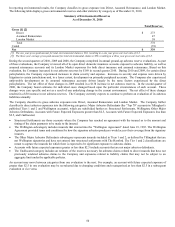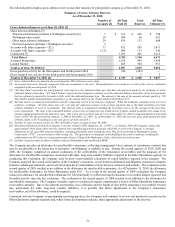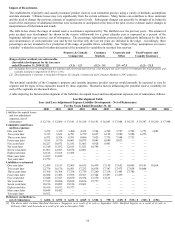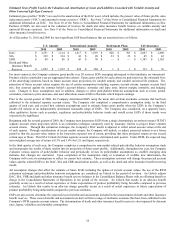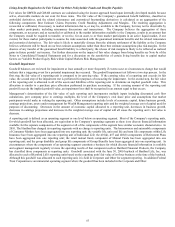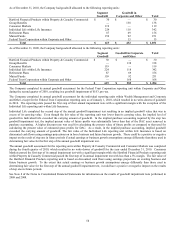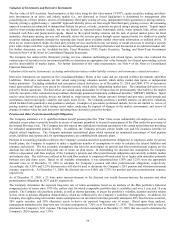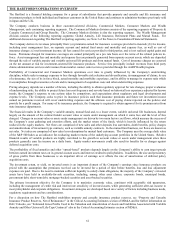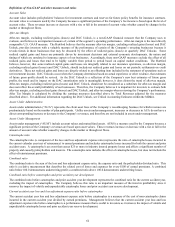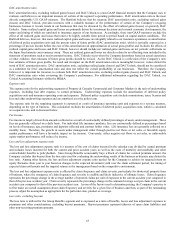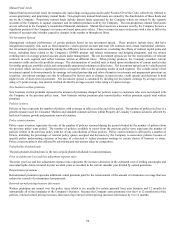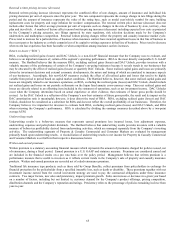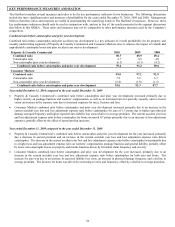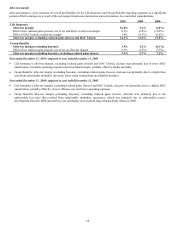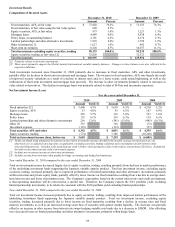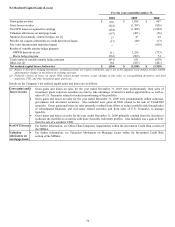The Hartford 2010 Annual Report Download - page 60
Download and view the complete annual report
Please find page 60 of the 2010 The Hartford annual report below. You can navigate through the pages in the report by either clicking on the pages listed below, or by using the keyword search tool below to find specific information within the annual report. 60
Pension expense reflected in the Company’ s results was $186, $137 and $122 in 2010, 2009 and 2008, respectively. The Company
estimates its 2011 pension expense will be approximately $210, based on current assumptions. To illustrate the impact of these
assumptions on annual pension expense for 2011 and going forward, a 25 basis point decrease in the discount rate will increase pension
expense by approximately $15 and a 25 basis point change in the long-term asset return assumption will increase/decrease pension
expense by approximately $10.
The Company uses a five-year averaging method to determine the market-related value of Plan assets, which is used to determine the
expected return component of pension expense. Under this methodology, asset gains/losses that result from returns that differ from the
Company’ s long-term rate of return assumption are recognized in the market-related value of assets on a level basis over a five year
period. The difference between actual asset returns for the plans of $434 and $184 for the years ended December 31, 2010 and 2009,
respectively, as compared to expected returns of $286 and $276 for the years ended December 31, 2010 and 2009, respectively, will be
fully reflected in the market-related value of plan assets over the next five years using the methodology described above. The level of
actuarial net loss continues to exceed the allowable amortization corridor. Based on the 5.50% discount rate selected as of December
31, 2010 and taking into account estimated future minimum funding, the difference between actual and expected performance in 2010
will decrease annual pension expense in future years. The decrease in pension expense will be approximately $7 in 2011 and will
increase ratably to a decrease of approximately $50 in 2016.
Valuation Allowance on Deferred Tax Assets
Deferred tax assets represent the tax benefit of future deductible temporary differences and operating loss and tax credit carryforwards.
Deferred tax assets are measured using the enacted tax rates expected to be in effect when such benefits are realized if there is no change
in tax law. Under U.S. GAAP, we test the value of deferred tax assets for impairment on a quarterly basis at the entity level within each
tax jurisdiction, consistent with our filed tax returns. Deferred tax assets are reduced by a valuation allowance if, based on the weight of
available evidence, it is more likely than not that some portion, or all, of the deferred tax assets will not be realized. The determination
of the valuation allowance for our deferred tax assets requires management to make certain judgments and assumptions. In evaluating
the ability to recover deferred tax assets, we have considered all available evidence as of December 31, 2010, including past operating
results, the existence of cumulative losses in the most recent years, forecasted earnings, future taxable income, and prudent and feasible
tax planning strategies. In the event we determine it is not more likely than not that we will be able to realize all or part of our deferred
tax assets in the future, an increase to the valuation allowance would be charged to earnings in the period such determination is made.
Likewise, if it is later determined that it is more likely than not that those deferred tax assets would be realized, the previously provided
valuation allowance would be reversed. Our judgments and assumptions are subject to change given the inherent uncertainty in
predicting future performance and specific industry and investment market conditions.
The Company has recorded a deferred tax asset valuation allowance that is adequate to reduce the total deferred tax asset to an amount
that will more likely than not be realized. The deferred tax asset valuation allowance was $173 as of December 31, 2010 and $86 as of
December 31, 2009. The increase in the valuation allowance during 2010 was triggered by the recognition of additional realized losses
on investment securities which were incurred in the first quarter. In assessing the need for a valuation allowance, management
considered future reversals of existing taxable temporary differences, future taxable income exclusive of reversing temporary
differences and carryforwards, and taxable income in prior carryback years, as well as tax planning strategies that include holding a
portion of debt securities with market value losses until recovery, selling appreciated securities to offset capital losses, business
considerations, such as asset-liability matching, and the sales of certain corporate assets, including a subsidiary. Such tax planning
strategies are viewed by management as prudent and feasible and will be implemented if necessary to realize the deferred tax asset.
Future economic conditions and debt market volatility, including increases in interest rates, can adversely impact the Company’ s tax
planning strategies and in particular the Company’ s ability to utilize tax benefits on previously recognized realized capital losses.
Contingencies Relating to Corporate Litigation and Regulatory Matters
Management evaluates each contingent matter separately. A loss is recorded if probable and reasonably estimable. Management
establishes reserves for these contingencies at its “best estimate,” or, if no one number within the range of possible losses is more
probable than any other, the Company records an estimated reserve at the low end of the range of losses.
The Company has a quarterly monitoring process involving legal and accounting professionals. Legal personnel first identify
outstanding corporate litigation and regulatory matters posing a reasonable possibility of loss. These matters are then jointly reviewed
by accounting and legal personnel to evaluate the facts and changes since the last review in order to determine if a provision for loss
should be recorded or adjusted, the amount that should be recorded, and the appropriate disclosure. The outcomes of certain
contingencies currently being evaluated by the Company, which relate to corporate litigation and regulatory matters, are inherently
difficult to predict, and the reserves that have been established for the estimated settlement amounts are subject to significant changes.
In view of the uncertainties regarding the outcome of these matters, as well as the tax-deductibility of payments, it is possible that the
ultimate cost to the Company of these matters could exceed the reserve by an amount that would have a material adverse effect on the
Company’ s consolidated results of operations or cash flows in a particular quarterly or annual period.


